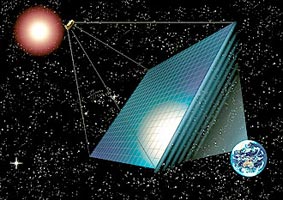Japan wants to build a solar power plant on the universe
The Japan Space Discovery Agency (JAXA) is determined to pursue the plan: harnessing solar power in space and transmitting it to Earth using laser or microwave technology. JAXA has recruited a number of companies and experts in charge of making the dream of owning billions of dollars worth of clean clean energy a reality in the next few decades.
Capital is not favored by many natural energy sources and must depend largely on imported oil and gas resources, the sunrise has long become the 'leader' in the field of solar power and energy sources. Other regeneration. This year, the Japanese government also aims to drastically cut greenhouse gas emissions.

Japan's future solar power station will be like this.Photo: AFP
The Space Solar Power System (SSPS) is considered Japan's most daring project. Accordingly, photovoltaic panels of many kilometers in size will hover over geostationary orbits outside the Earth's atmosphere.'Because the Solar Power is a clean and never-ending energy source, we believe SSPS will be able to help solve the global energy and warming problem' , experts of the Mitsubishi Group, one in the project partners, said.
Photovoltaic cells will capture solar energy in space - with a intensity of at least 5 times that of the ground - then transfer it to the ground through laser beams or microwaves. According to Tadashige Takiya, a JAXA spokesperson, the power source will be placed on a giant parabolic antenna system near the sea or on receiving hydroelectric reservoirs.
Currently, JAXA is targeting the solar power system in the universe with a design capacity of 1 gigawatt - equivalent to the capacity of an average nuclear power plant - expected to produce electricity for 8 yen / kW, 6 times cheaper than current prices in Japan.
The technical challenge, including transporting components to space, will be a big obstacle, but Japan has been studying SSPS technology since 1998 with the participation of about 130 experts working under supervision. of JAXA. Last October, the Ministry of Economy and Trade and the Japanese Ministry of Science put the SSPS project one step further when it selected several leading technology corporations such as Mitsubishi, NEC, Fujitsu and Sharp as partners.
It is expected that by 2020, Japan will launch and run the first SSPS test with a capacity of 10 megawatts, followed by a 250 megawatt system.
- China aspires to build the first solar power plant in space
- Japan built the largest solar power plant
- The world's largest floating solar power plant
- New trend: Solar power floats on water
- Build solar power plant in HCMC
- The world's largest solar power plant comes into operation
- Toshiba will enter the solar market
- Operating the world's largest solar power plant
- Unique power plant shaped wine glasses
- Japan studied building solar power station in the universe
- Solar plant operates at night
- The solar power plant is made of 10,000 giant mirrors
 Is the magnetic North Pole shift dangerous to humanity?
Is the magnetic North Pole shift dangerous to humanity? Washington legalizes the recycling of human bodies into fertilizer
Washington legalizes the recycling of human bodies into fertilizer Lightning stone - the mysterious guest
Lightning stone - the mysterious guest Stunned by the mysterious sunset, strange appearance
Stunned by the mysterious sunset, strange appearance How do the superpowers build nuclear power models?
How do the superpowers build nuclear power models?  China successfully builds megawatt-scale space nuclear reactor
China successfully builds megawatt-scale space nuclear reactor  US successfully transmits solar power from space to Earth
US successfully transmits solar power from space to Earth  Scene of more than 150 tons of jellyfish destroying a power plant in China
Scene of more than 150 tons of jellyfish destroying a power plant in China  Elon Musk's Giant Supercomputer: Powered by 150MW, Ready to Simultaneously Operate 100,000 GPUs
Elon Musk's Giant Supercomputer: Powered by 150MW, Ready to Simultaneously Operate 100,000 GPUs  China operates giant offshore solar farm
China operates giant offshore solar farm 